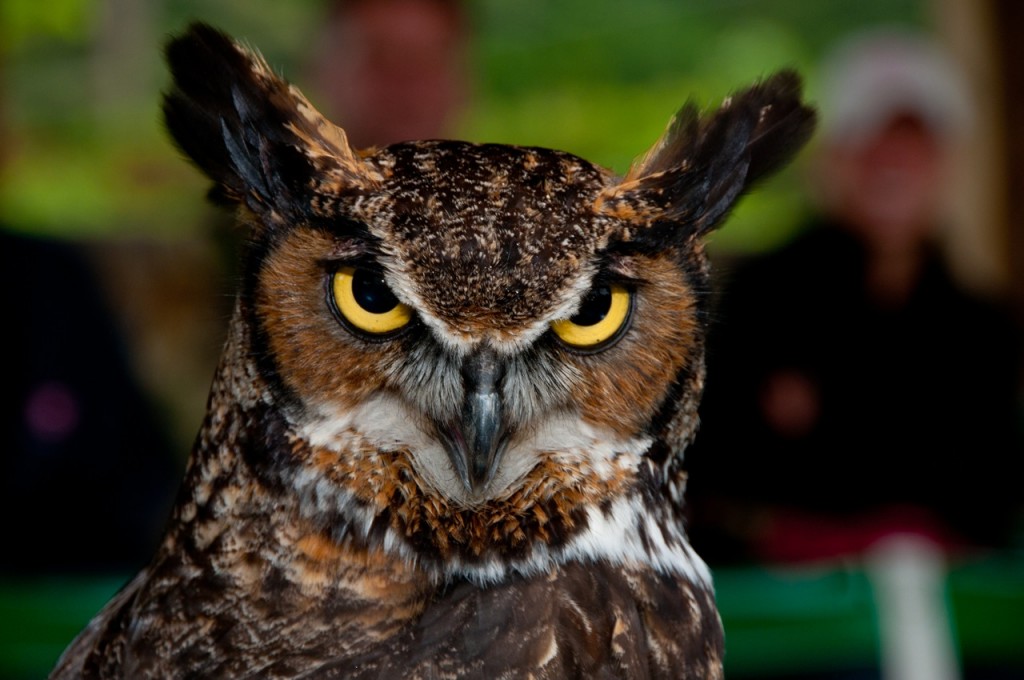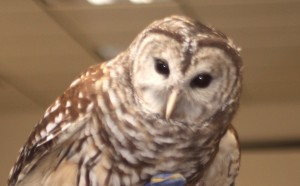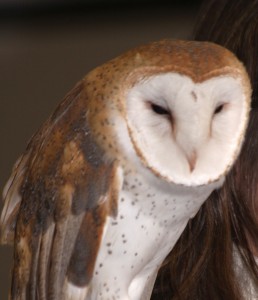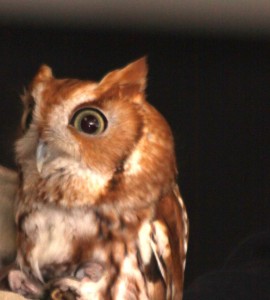Give a Hoot
As Shakespeare noted in Love’s Labor’s Lost, when icicles hang by the wall and milk comes home frozen in the pail, then nightly sings the staring owl. And so it is in our forested bluff lands, as our resident owls court and mate in the cold of February, and do a lot of talking in the process.
Owls command the night, skillfully and silently maneuvering in darkness, because of several superb evolutionary adaptations. Owls have stupendous hearing, particularly for high and low frequencies, and can detect the slight noise of a scurrying mouse from a ⅓ mile distance. The mouse, however, gets no audible clues that an owl might be flying about, because the unique wing feather construction of owls allows them to fly silently and stealthily swoop down on prey. In addition, their short and broad wings, coupled with small body weight, make them highly maneuverable fliers. But an owl’s unbelievably acute vision makes them the most lethal nighttime raptor and predator.
An owl’s eyes are huge in proportion to their bodies. A human’s eyes take up only 2% of their face. A great horned owl’s eyes are so enormous relative to its head that if human eyes were comparably sized, they would be the size of oranges. And nothing disappears from view – even in the blink of an eye. Like all raptors, owls have a nictitating membrane, a transparent extra eyelid, to protect and moisten the eyes without blinking and losing a split-second’s worth of vision.
An owl’s eyes weigh more than and are as large as its brain. Their eyes have three kinds of photoreceptors (we only have two) to perceive details and colors, especially in no- or low-light conditions, enabling them to see far beyond human visual ranges. An owl’s retina, unlike ours, contains few blood vessels. Instead, a thin folded tissue called pectin brings blood and nutrients to their eye without casting shadows or scattering light as the blood vessels in our eyes do.
Most mammals, including us, and most birds have a single area within the eye with perfect vision, called the fovea, where cone cells, which detect sharp contrast and detail, are most concentrated. But a raptor’s eye has two fovea: one is for lateral vision, the other for forward vision. A human eye has two hundred thousand cones for each square millimeter of fovea. Owls have more than a million.
Thanks to their second fovea, owls also have a wider field of vision and better depth perception than we do. And, the flat faced and forward facing position of an owl’s eyes make for superior binocular vision, with overlapping views from the right and left eye. An owl’s brain can rapidly differentiate images and instantly calculate distances.
An owl on the wing at 500 feet above ground can easily spot prey within a one square mile area. An owl’s ability for instant imaging makes them think much differently than we do. To us, seeing is believing. To an owl, seeing is being.
Four species of owls are year-round residents of our bluff lands. Great-horned owls, the second largest owl in North America at a height of two feet, inhabit a variety of areas, from forest, to field edges, to steeples in towns. Their deep and loud “hoots” are unmistakable and can be heard from great distances.
Barred owls are common residents of our forests and call out a distinctive “who-cooks-for-you” in their nightly escapades. Eastern screech-owls, the smallest owl in our area at 8″ tall, live in a variety of wooded habitats and call with easy to recognize quavering whistles and trills. Finally, our increasingly hard to find barn owls, creatures of open grasslands, with telltale and beautiful heart-shaped snow white faces, give off a subtle and raspy screech.
All four of these species are establishing territories and courting as they begin mating in February and generally talk up a storm in the process. Three other owl species winter in our area but breed in Canada, and might be sounding off in the bluff lands and bottom lands in February just to be social before returning north: long-eared owls, short-eared owls and northern saw-whet owls.
The intention of all the owl talk, of course, is to attract a mate and begin anew the annual process of raising a family. Our year-round residents, great-horned, barred, Eastern screech, and barn owls, all expend great energy and care raising their broods of chicks. All four species nest in some type of cavity or protected ledge, and will use the old nest of other birds or even squirrels. Owls rarely spend effort on actual nest building, but will scrap together any debris left in the area; barn owls add a set of regurgitated pellets as an outer lining to their nest scrapes. Females generally lay their eggs over several days but begin incubation after laying the first egg. The owlets hatch over a several days with the last one often disadvantaged by older and bigger siblings.
Young owlets leave the nest before they can fly, often perching near the nest site for several additional weeks of constant parental care and feeding. Even after the young birds are able to fly, they continue to rely upon the adult pair for much of their first six months of only semi-independent life. By late summer and early fall, the young birds finally are able to care for themselves while their parents again resume largely solitary living until the winter’s chill again invites them to call a mate into a nesting territory.
CLIFFTOP, a local nonprofit organization, is focused on preserving and protecting area bluff lands.
A version of this article appeared in the 15 February 2013 edition of the Monroe County Independent.
© 2013 all content rights reserved, Clifftop NFP
Comments are currently closed.




